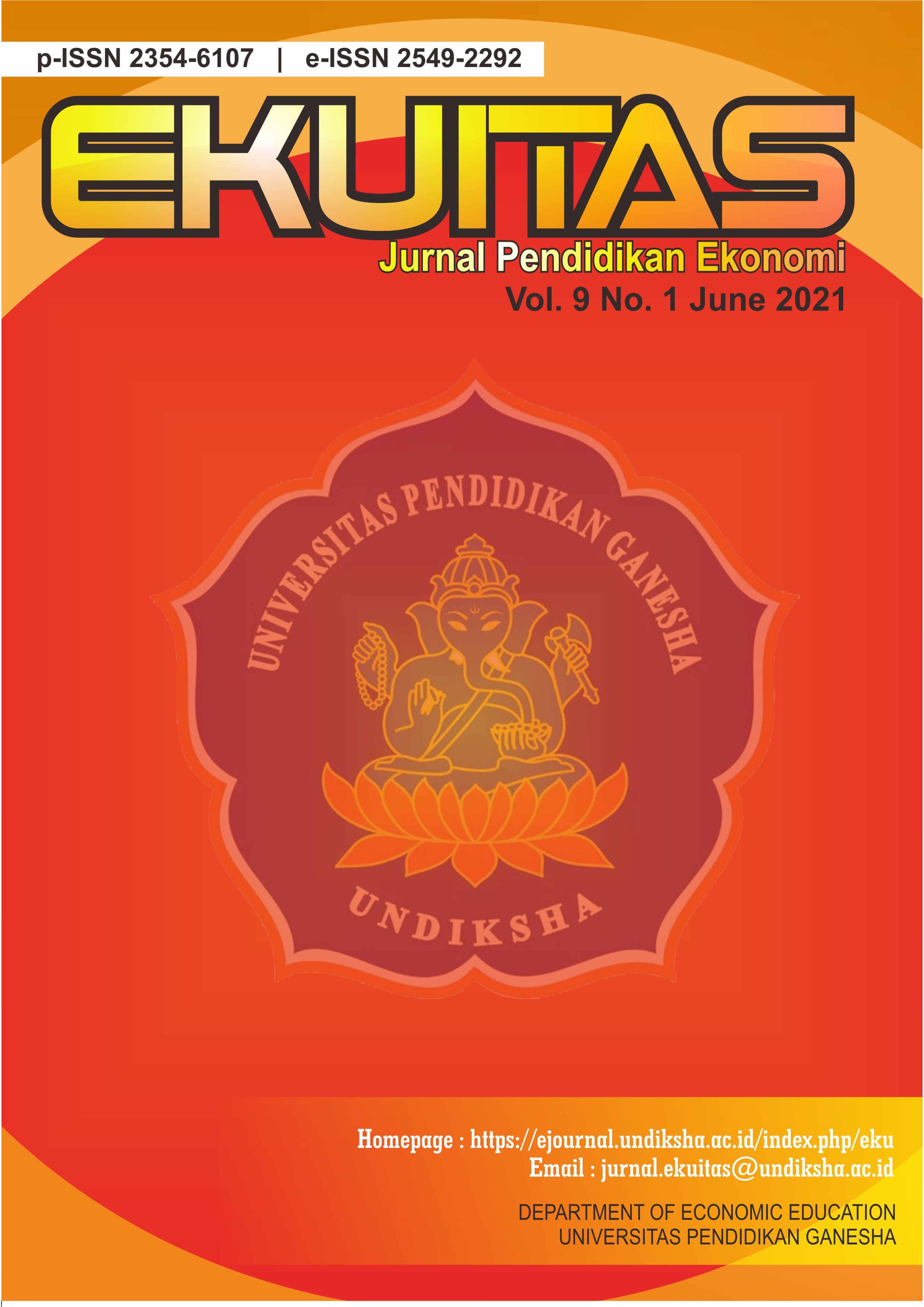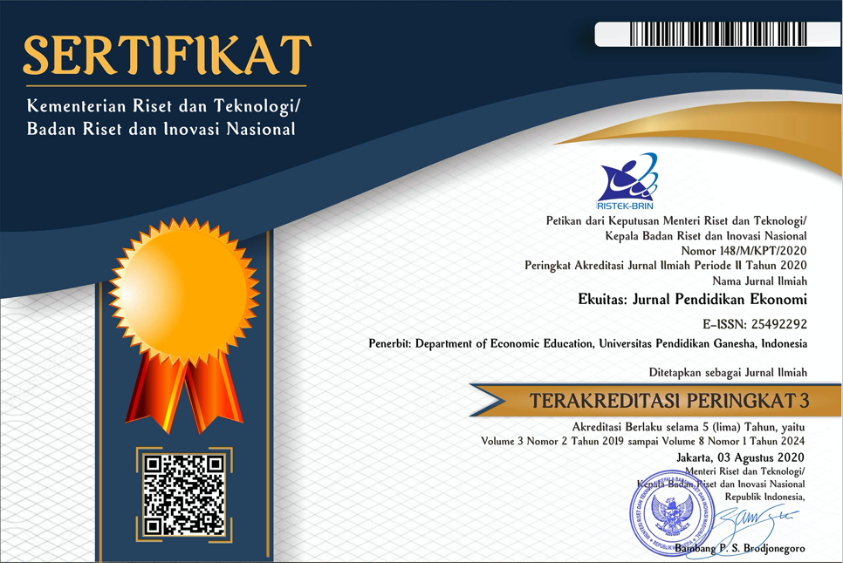Efektivitas Model Pembelajaran Blended Learning dalam Meningkatkan Kemandirian dan Hasil Belajar Peserta Didik pada Masa Pandemi Covid-19
DOI:
https://doi.org/10.23887/ekuitas.v9i1.34186Keywords:
blended learning, independent learning, learning outcomesAbstract
This research aims to analyze the effectiveness of the Blended Learning learning model that was applied during the Covid-19 pandemic and is seen based on the responses of students. In addition, this research also aims to analyze how effectively the Blended Learning model is able to increase learning independence and student learning outcomes. This research belongs to the type of quantitative research that uses a quasi-experimental approach with a Posttest Only Control Group Design. The population in this study was class XI IPS at SMAN 1 Puri, Mojokerto. The sampling technique used was the Simple Random Side technique and obtained class XI IPS 1 as the control class and XI IPS 3 as the Experiment class. The research data comes from primary and secondary data. Primary data comes from posttest scores, independence questionnaires and student responses. Meanwhile, secondary data was obtained based on documentation on the value and attendance of students. This research succeeded in proving that blended learning learning could be carried out with a percentage of 95.83%. The effectiveness of the Blended learning model shows a percentage of 73.84%. The implementation of the Blended Learning model is also effective in increasing learning independence which is shown in the Sign value (2-tailed) is 0.021 <0.05, and can also improve student learning outcomes shown in the Sign (2-tailed) value is 0.032 <0, 05.References
Aunurrohman. (2013). Belajar dan Pembelajaran. Alfabeta.
Azis, Y. M. (2013). the Effectiveness of Blended Learning , Prior Knowledge. Contemporary Issues In Education Research, 2(2), 106–116.
Baroh, C. (2010). Efektivitas Metode Stimulasi dalam Pembelajaran Matematika pada Pokok Bahasan Peluang di Kelas IX-A MTS Nurul Huda Kalanganyar Sedati Sidoarjo. Skripsi Pendidikan Mateatika.
Bonk, C. J., Graham, C. R., Cross, J., & Moore, M. G. (2005). The Handbook of Blended Learning: Global Perspectives, Local Designs. Pfeiffer.
Chaeruman, U. A. (2019). Merancang Model Blended Learning Designing Blended Learning Model. Jurnal Teknodik, 17(4), 053. https://doi.org/10.32550/teknodik.v17i4.577
Chick, R. C., Clifton, G. T., Peace, K. M., Propper, B. W., Hale, D. F., Alseidi, A. A., & Vreeland, T. J. (2020). Using Technology to Maintain the Education of Residents During the COVID-19 Pandemic. Journal of Surgical Education, 77(4), 729–732. https://doi.org/10.1016/j.jsurg.2020.03.018
Damayanthi, A. (2020). Efektivitas Pembelajaran Daring di Masa Pandemi Covid 19. JURNAL SOSIAL :Jurnal Penelitian Ilmu-Ilmu Sosial, 21(3), 53–56.
Darma, I. K., Karma, I. G. M., & Santiana, I. M. A. (2020). Blended Learning, Inovasi Strategi Pembelajaran Matematika di Era Revolusi Industri 4.0 Bagi Pendidikan Tinggi. Prosiding Seminar Nasional Pendidikan Matematika, 3, 527–539.
Fajar, R., & Riantika, P. (2019). Efektivitas Model Pembelajaran Blended Learning untuk Meningkatkan Hasil Belajar Geografi pada Materi Litosfer Kelas X SMA. 2, 1723–1729.
Farida, A., & Indah, R. P. (2019). Penerapan Blended Learning Untuk Peningkatan Kemandirian Belajar Dan Critical Thinking Mahasiswa. Jurnal Derivat: Jurnal Matematika Dan Pendidikan Matematika, 5(2), 19–27. https://doi.org/10.31316/j.derivat.v5i2.138
Fauci, A. S., Lane, H. C., & Redfield, R. R. (2020). Covid-19 — Navigating the Uncharted. New England Journal of Medicine, 382(13), 1268–1269. https://doi.org/10.1056/nejme2002387
Fitriasari, P., & Sari, N. (2017). Implementasi blended learning untuk meningkatkan kemandirian belajar mahasiswa pada mata kuliah metode numerik. Prosiding Seminar Nasional Pendidikan Matematika 2017, 2010, 1–10.
Garner, B., & Oke, L. (2014). Blended Learning:Theoretical Foundation. Indiana Wesleyan University.
Heinich, R., Molenda, M., Russell, J., & Smaldino, S. (2012). Instructional Media and Technology for Learning. International Journal of Distributed and Parallel Systems, 3, 8.
Kazu, I. Y., & Demirkol, M. (2014). EFFECT OF BLENDED LEARNING ENVIRONMENT MODEL ON HIGH SCHOOL STUDENTS ’ ACADEMIC ACHIEVEMENT. The Turkish Online Journal of Educational Technology, 13(1), 78–87.
López-pérez, M. V., Pérez-lópez, M. C., & Rodríguez-ariza, L. (2011). Blended learning in higher education : Students ’ perceptions and their relation to outcomes. Computers & Education, 56(3), 818–826. https://doi.org/10.1016/j.compedu.2010.10.023
Marzano, R. ., Pickering, D., & McTighe, J. (1993). Assessing Students Outcomes,Performance Assessment Using The Dimensions of Learning Model. ASCD.
Ningsih, Y. L., Misdalina, M., & Marhamah, M. (2017). Peningkatan Hasil Belajar dan Kemandirian Belajar Metode Statistika Melalui Pembelajaran Blended Learning. Al-Jabar : Jurnal Pendidikan Matematika, 8(2), 155. https://doi.org/10.24042/ajpm.v8i2.1633
Novitayati, R. (2013). Pengaruh Metode Blended Learning dan Self Regulated Learning Terhadap Hasil Belajar Kognitif IPS. Jurnal Penelitian Pendidikan, 1, 48–57.
Rachmawati, Y., Ma’arif, M., Fadhillah, N., Inayah, N., Ummah, K., Siregar, M. N. F., Amalyaningsih, R., C., F. A. A., & F., A. A. (2020). Studi Eksplorasi Pembelajaran Pendidikan IPA Saat Masa Pandemi COVID-19 di UIN Sunan Ampel Surabaya. Indonesian Journal of Science Learning, Volume 1,(1), 32–36.
Riduwan. (2010). Skala Pengkuran Variabel-variabel Penelitian. Alfabeta.
Staley, L. (2007). Where Mind Meet.
Standard, I., & Numbers, B. (2008). Brescia-2008-British_Journal_of_Educational_Technology. British Journal of Educational Technology, 39(4), 117–129.
Sukirwan. (2020). PEMBELAJARAN DARI RUMAH DARI KLASIKAL KE DIGITAL. Akrab Juara, 5(1), 43–54.
Uz, R., & Uzun, A. (2018). The Influence of Blended Learning Environment on Self-Regulated and Self-Directed Learning Skills of Learners. European Journal of Educational Research, 7(4), 877–886. https://doi.org/10.12973/eu-jer.7.4.877
Wai, C. C., Lim, E., & Seng, K. (2014). Exploring the effectiveness and efficiency of blended learning tools in a school of business. Procedia - Social and Behavioral Sciences, 123(2002), 470–476. https://doi.org/10.1016/j.sbspro.2014.01.1446
Wakhudin, Romadlon, F., Sirega, J., Firmansyah, Sani, R. A., Pangarso, A., Hart, J., Rusnedy, R., Purnomo, M., Nuvriasari, A., Harsoyo, T. D., Mirdayanti, R., Retnoningtia, D. W., Hardika, I. R., Sahrah, A., & Abdul, S. V. P. | R. A. | T. N. E. D. S. | M. O. L. | D. R. P. R. | M. R. R. | R. Y. | S. L. C. | E. A. | A. S. | A. N. (2020). Dalam Ragam Tinjauan (D. H. Santoso & A. Santosa (eds.)). MBridge Press.
Watson, J., Powell, A., Staley, P., Patrick, S., Horn, M., Fetzer, L., Hibbard, L., Oglesby, J., Verma, S., Education, M., C, T. O. C.-I. N. B., Kuehn, B. L., Ed, D., Archibald, D., Barbour, M. K., Leary, H., Wilson, E. V., & Ostashewski, N. (2020). Teacher education and K-12 online learning. INACOL, The International Association for K–12 Online Learning, July, 1–20.
Yuliati, Y., & Saputra, D. S. (2020). Membangun Kemandirian Belajar Mahasiswa Melalui Blended Learning Di Masa Pandemi Covid-19. Jurnal Elementaria Edukasia, 3(1), 142–149.








